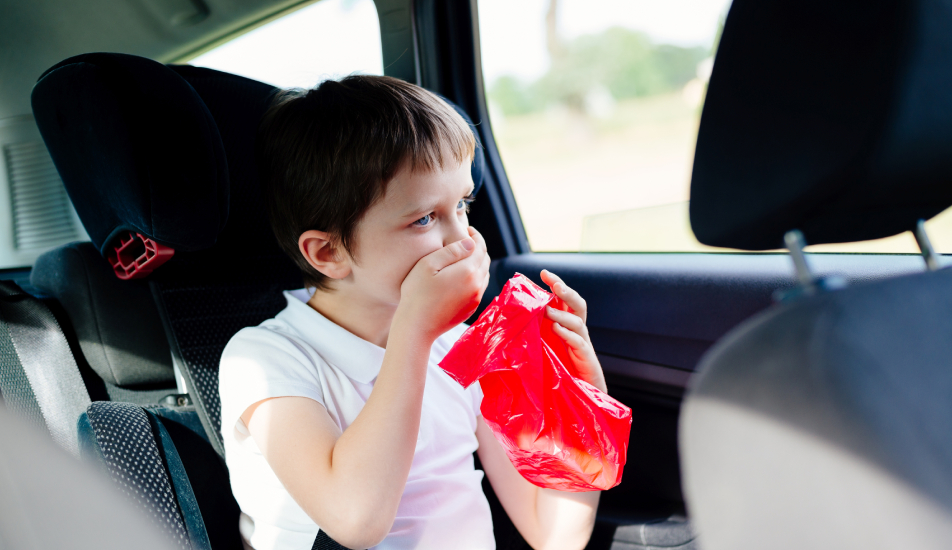
Motion Sickness in Children
Motion sickness in kids
When it’s time for your family holiday, does your excitement come with a side of dread – just knowing you’re bound to hear tiny sad voices say, “my tummy doesn’t feel very good…”? Well, we can tell you that you’re not the only one!
Motion sickness, or travel sickness, describes those occasions when you start feeling unwell when you are in a moving vehicle. Given enough movement, motion sickness can affect anyone – but it tends to occur more often in kids than in adults. Reports show that up to 10% of all kids aged 3 months to 18 years are prone to getting motion sickness, and over 40% of 7- to 12-year-old children experience motion sickness when they travel by car.
Why do kids get motion sickness?
Motion sickness occurs when your senses get muddled up because what your brain expects to see and feel whilst in a moving vehicle does not match up with what you actually see and feel. This sensory mismatch causes motion sickness in both adults and children, but age is thought to affect your sensitivity to this mismatch. It also appears that kids are more likely to experience motion sickness if one or both of their parents had motion sickness when they were a child.
The important question is how kids’ motion sickness changes with age. Motion sickness rarely occurs in children under 2 years of age, possibly because signals from the eyes to the brain are less important in babies and young toddlers. After this age, the frequency of motion sickness increases until kids hit puberty. Motion sickness is most common in children aged 4 to 13 years, with a peak at around 9 years of age – suggesting that it’s around this age that kids appear to be most sensitive to the sensory mismatch that causes motion sickness. Beyond 13 years of age, motion sickness occurs less and less frequently as teenagers become young adults and their senses get used to vehicle movements when travelling.
Kids’ motion sickness symptoms
The most common symptom of motion sickness is nausea, which might make your kids feel sick or uncomfortable in their stomachs. You’ll want to watch out for some of these other common signs or symptoms of motion sickness, including:
- Sweating
- Feeling dizzy
- Skin becoming pale
- Getting drowsy
- Headaches
- Vomiting
Treatment and relief for kids’ motion sickness
It’s no fun travelling when little ones who feel unwell, so think about helping prevent motion sickness from kicking in by trying a motion sickness medicine for kids. Motion sickness medications are designed to be taken before travelling to help prevent motion sickness before it starts. They work by blocking sensory signals from reaching the brain’s vomiting centre. SEA-LEGS® chewable tablets contain the antihistamine meclozine, which provides effective motion sickness relief for up to 24 hours. They are suitable for children from 6 years of age and should be taken at least 1 hour before travelling.
If you need some other ideas to help prevent or relieve symptoms of motion sickness in your kids, consider trying the following:
- Playing road-trip games or singing to help your child focus on things outside the car
- Avoid reading books or looking down at phones or tablet screens during the trip
- Stick to small, plain meals and snacks before and during a long trip, and remember to keep up water intake
- Have fresh air circulating inside the vehicle – stuffy air and bad smells can trigger motion sickness or make symptoms worse
- Consider travelling during nap time or the night so that your child will spend most of the trip asleep
So for a family holiday that’s memorable for all the right reasons – don’t forget your SEA-LEGS!
Always read the label and follow directions for use.
Frequently asked questions about motion sickness in children
SEA-LEGS® chewable tablets are suitable for children from 6 years of age. When looking for kids’ motion sickness medicine, always read the label and follow the directions for use. Do not give to children under 6 years of age.
Children under 2 years of age rarely experience motion sickness, possibly because sensory input from their eyes is less important. Also, babies usually lie down when travelling, which may lessen the likelihood of motion sickness.
Travelling at night may help prevent motion sickness in kids because fewer sensory signals will go to their brains when they are asleep with their eyes closed.
The mismatch of sensory information received by the brain that triggers motion sickness can happen in any moving vehicle. But what triggers car sickness in your child (e.g., windy roads, sitting in the backseat) might not trigger other types of motion sickness, and vice versa (e.g., rocking waves on boats, air turbulence in planes).
